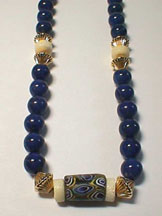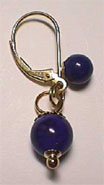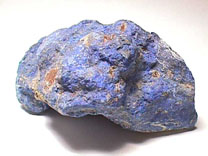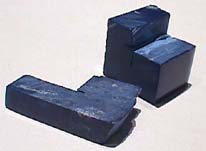The Gemstones
Lapis Lazuli

Lapis Lazuli beads strung with 14kt. yellow gold accents and African trading beads from the 17th Century
Consumer Information
 What color is it?: Various shades of blue with some qualities being mottled with white calcite and some with yellow pyrite. The finest Lapis Lazuli should an nice even blue color with little or no veining from these other elements.
What color is it?: Various shades of blue with some qualities being mottled with white calcite and some with yellow pyrite. The finest Lapis Lazuli should an nice even blue color with little or no veining from these other elements.
What is the story behind this gemstone?: For centuries Lapis Lazuli has been prized for jewelry. But it has also been used to make the beautiful blue paint used in Middle Ages art, and has been used as a source of writing instruments, hence the name "lapis" which is Spanish for pencil.
Can I wear it everyday?: Yes, Lapis Lazuli is actually a rock since it is composed of a combination of minerals so it wears very well.
Is it expensive?: Fine natural Lapis Lazuli can be rather pricey. Jewelry with the high quality stones with no calcite or pyrite veins can be quite expensive. However, medium to lower price ranges are possible if you don't mind having some of the vein in the stones.
Is it a birthstone?: No.
What do I need to know before going shopping?: There is quite a bit of treated Lapis Lazuli out on the market. These are stones that are artificially dyed to appear darker in color. Some fingernail polish remover and a Q-Tip will tell, however, since the dye will come off quickly. So be aware that if you are offered a nice strand of dark blue Lapis Lazuli beads for a very low price they may be treated. If you are informed about this at time of sale then there is no problem. But if you are not told you should be wary of high quality beads at low prices. Something is amiss....
 General Information
General Information
Source: Afghanistan, Egypt, South America, other world sources
Chemical: A combination of lazurite and other minerals forming a rock.
Formation: See photo above.
Crystal System: None
Unusual Properties: Streaking of gold pyrite and/or white calcite is considered a preferable quality to some.
 Gemological Information
Gemological Information
Very good imitation of lapis lazuli of which gemologists should be aware
RI: 1.500 - 1.670
Birefringence: None
Optic Character: None
Specific Gravity: 2.75
Hardness: 5-6
Transparency: Opaque
Special Identifying Properties and Tests: Natural Lapis Lazuli will show a faint red reaction to the Chelsea Filter
Synthetics: None
Imitations: Many including Gilson imitation lapis, and varying treatments and dyes of natural low quality stones.
F
